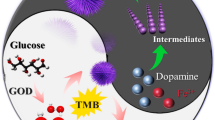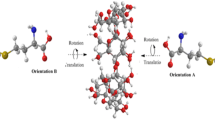Abstract
Formation and stability of different aldehydic dextran-hemoglobin conjugates were studied. Two types of polymers were used: sulfated or unsulfated oxidized dextrans and 4-carboxamidobenzaldehyde dextran. Periodate-oxidized dextran forms imine and ketoamine linkages by reaction with hemoglobin and the obtained conjugates are not completely stable, as their molecular size increases with time or decreases after incubation with lysine. The sulfated conjugates are more sensitive to lysine action than the unsulfated ones, which is consistent with the decreased possibilities of Amadori rearrangement. Therefore, this proves the importance of ketoamines for ensuring the cohesion of oxidized dextran-based conjugates. Carboxamidobenzaldehyde dextran forms only imine linkages with hemoglobin and the corresponding conjugates possess a marked instability in the absence of reductive treatment. The different types of conjugates could be stabilized by a sodium borohydride treatment in a satisfying manner.
Similar content being viewed by others

References
Amiconi, G., Zolla, L., Vecchini, P., Brunori, M., and Antonini, E. (1977).Eur. J. Biochem. 76, 339–343.
Bonneaux, F., Labrude, P., and Dellacherie, E. (1981).Experientia 37, 884–886.
Dellacherie, E., and Bonneaux, F. (1993).Polymer Bull. 31, 145–149.
Dellacherie, E., Bonneaux, F., Labrude, P., and Vigneron, C. (1983).Biochim. Biophys. Acta 749, 106–114.
Isbell, H. S., and Frush, H. L. (1958).J. Org. Chem. 23, 1309–1319.
Jamieson, G. A., and Greenwalt, T. S. (1978).Progress in Chemical and Biological Research, Vol. 19, Liss, New York.
Labrude, P., Mouelle, P., Menu, P., Vigneron, C., Dellacherie, E., Leonard, M., and Taylot, J. L. (1988).Int. J. Art. Organs 11, 393–402.
Ricketts, C. R. (1952).Biochem. J. 51, 129–133.
Siggia, S. (1963).Quantitative Organic Analysis via Functional Groups, J. Wiley, New York.
Tam, S. C., Blumenstein, J., and Wong, J. T. F. (1978).Can. J. Biochem. 56, 981–984.
Zaugg, R. H., Walder, J. A., and Klotz, I. M. (1977).J. Biol. Chem. 252, 8542–8548.
Author information
Authors and Affiliations
Rights and permissions
About this article
Cite this article
Bonneaux, F., Dellacherie, E. Fixation of various aldehydic dextrans onto human hemoglobin: Study of conjugate stability. J Protein Chem 14, 1–5 (1995). https://doi.org/10.1007/BF01902838
Received:
Published:
Issue Date:
DOI: https://doi.org/10.1007/BF01902838



